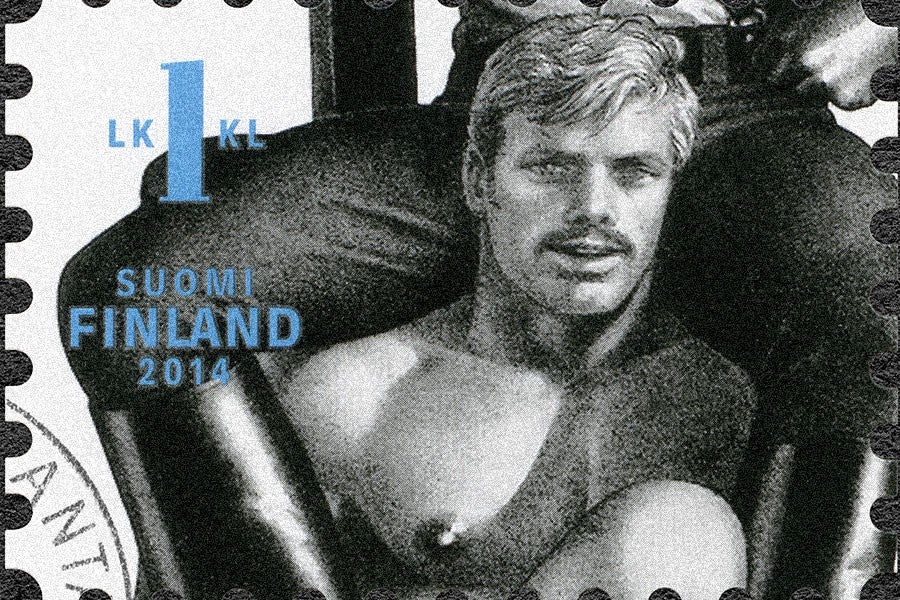“I know my little ‘dirty drawings’ are never going to hang in the main salons of the Louvre, but it would be nice if — I would like to say ‘when,’ but I better say ‘if’ — our world learns to accept all the different ways of loving. Then maybe I could have a place in one of the smaller side rooms,” Touko Laaksonen, better known as Tom of Finland, said in 1991, the same year as his death in Helsinki, the city where he spent most of his life.
Although there still aren’t any Tom of Finland pieces in the Louvre, at least so far, his photorealistic drawings have been the focus of major exhibitions in L.A., New York, London, Stockholm and, well, Finland. Known for his hypermasculine erotica, in which lumberjacks and construction workers wield huge dicks that peek out underneath their professional wears, Tom of Finland’s homoerotica made him one of the most influential artists of the 20th century — an artistry that’s the subject of Dome Karukoski’s new film Tom of Finland, a two-hour exploration of everything from Laaksonen’s inspiration to his influence.
We meet Tom as Touko and get a sense of his emotional state through a series of intercuts that show him having anal sex amid aircraft warnings during World War II, during which he was a decorated officer, and at home after the war — strong but isolated because of his sexuality. Through dreams that function as flashbacks, we see him caressing the attractive face of a Russian enemy he’s just killed in combat. We see his lover attacked in a park, beaten and arrested because he’s gay. And we see Touko the international spy held in Berlin, taunted by German police officers who suspect his sexuality and tell him he’s the type they throw into gas chambers. Perhaps most importantly, though, we see him using his early drawings to cruise, slipping them underneath bathroom stalls at social clubs in hopes of initiating sexual exchanges with other men.
Through all of this, we understand Tom’s incessant sketching as crucial to his survival in a country where his military service was celebrated but his sexuality denounced. His art becomes a tool by which he can determine how openly (or not) he wants to express himself. It’s easy to see the exaggerated masculinity he draws as both fetish and satire — those hardbodies representing the sort of dominance that mostly turns him on, but also controls him, highlighting the complexity of repression and how it can fuel hypersexuality.
In the second half of the film, Tom’s found an American publisher and begins making a living off of his art. He’s invited to L.A., where he meets a legion of his fans who consider him an icon of the Californian gay liberation movement of the 1970s, a time before AIDS, when sexual freedom was new, not consequential. We see Tom’s surprise when the cops raid a gay pool party only to ask for help locating the subject of a local robbery. One even pauses to pose for Tom’s camera—and of course, becomes another drawing in his massive repertoire.
The film is moving, elucidating the struggle of one man who wanted to be accepted by the country he went to war for, a powerful scenario that still rings true today for LGBTQ Americans who know that the degree to which they serve certain institutions isn’t always met with reciprocal support. But in the end, Tom’s fetish becomes the impetus for his success, part and parcel of the international aesthetic of gay liberation.
His legacy lives on today, particularly through the work of the Tom of Finland Foundation, the purpose of which is to support and archive erotic art.
Yet as the context from which his work was created evolves, so too does the way it’s interpreted, as L.A. DJ, artist and longtime follower of Tom of Finland James Cerne explains:
“For a lot of gay men, the archetypal Tom of Finland man embodies a lot of intense and complicated issues and social expectations that we as queer men wrestle with. Tom of Finland drawings are revolutionary in the way they challenged negative stereotypes of the gay man as a weak, disempowered pansy. Tom’s men look like superheroes, embodying everything about masculinity traditionally valued by society. The only difference was they fucked other men instead of women. He gave us this idea that we didn’t have to relinquish our manhood just to have sex with men. This was inspiring.
“But the issue I have now is that this outlook also reinforces the idea that femininity is bad. His work completely adheres to very specific anatomical proportions and a certain type of voracious sex drive that, given its popularity and eminence, has a silencing effect on the expressions of more varied male body types and ways of physically interrelating. In the end, I don’t think his work represents anything healthier than the stereotypes he challenged by creating it. In a lot of ways, I feel like he’s a victim of the patriarchy. And I see certain vestiges of that still permeating gay culture today.
“There’s absolutely an expectation that gay men are hyper-virile. As a DJ who works in many sexually charged spaces, I sometimes wonder if it’s a good thing that our culture puts so much attention on poppers and promiscuity. Not because I see those things as wrong, but because of how that doesn’t necessarily reflect my own preferred expression of desire. I think men, gay and straight, equate ‘good’ manhood with sexual voracity, which in my personal experience is a big part of toxic masculinity. I bear deep traumas from my past from men who I submitted to sexually, partly out of the expectation that as a man, refusing sex was… unmanly.”

